The
incisors
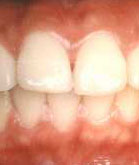
|
| Fig.3-1. The Central Incisors |
There are four in number, two in the upper arch and
two in the lower arch. The incisors are used for shearing and cutting.
The canines

|
|
Fig.3-2. The Canines
|
The longest
teeth in the mouth. Canines are located at the corners of the
mouth, both in the upper and lower arch, numbering four in all. Because
of its long, strongly developed roots, this teeth is usually the most stable.
Its crown contour also promotes a self cleansing property, thus making
it usually the last tooth to be lost.
Its function supports the function of both Incisors
and premolars. The name canine is derived from its resemblance to the prehensile
teeth of the Carnivora.
The Premolars
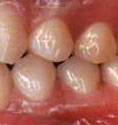
|
|
Fig.3-3. The Premolars
|
Most widely termed as bicuspid.
There are eight in number, four in the upper arch (two in each side, 1st
and 2nd Premolar) and same thing in the lower arch. These teeth are absent
in the primary set of teeth (or the baby teeth or milk teeth.) Premolars
succeed
the primary molars. And in case you have a chance with your Dentist to
do an RCT
on your upper First Premolar and wonder on the higher fee compared to doing
an RCT of an incisor, don't wonder now. Upper first Premolar have two roots
and two pulp canals. Although there are instances when the two roots are
fused, two pulp canals are always present anyway. The upper second Premolar
has one root and mostly has one pulp canals, although two pulp canals can
sometimes be present.
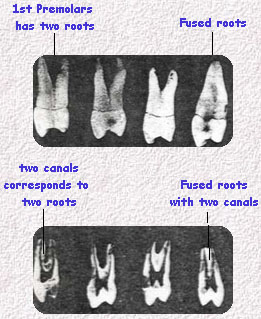
|
| Fig.3-7. Specimens of 1st Premolars showing
their roots and their pulp canals. |
|
The
molars (first and Second)
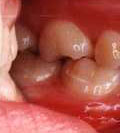
|
|
Fig.3-4. The molars.
|
There are actually a total of 12 molars in all, including
the third molars when present. There are three molars in each quadrant,
both in the upper and lower arch.
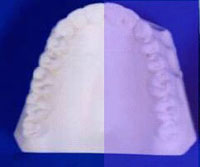
|
| Fig.3-5. A right or left quadrant means the
right or left of an arch, separated by the midline. |
As you can see above in our heading, I mentioned only
the first and second molars only. I intend to separate the third
molars since these teeth are always subjected to various anomalies and
variations. Thus, it has a special place then in this tour.
There are three molars in each quadrant, both in
the upper and lower arch. The first molar appears in the oral cavity at
the age of 6 years posterior
to the second
primary molar. The molars (both in the upper and lower arch)
are larger teeth which are used for grinding food. Although the upper molars
differ in size and anatomy of the lower molars, they are designed to perfectly
occlude
to each other. They have cusps
that rest on the grooves
of its opposing teeth.
The third molars
This is the tooth which we termed as the "Wisdom
Tooth." This tooth, as we have repeatedly state, is the most "abnormal"
of all teeth. This tooth can sometimes resemble the anatomy of another
tooth, can be large and can be very small, can have normal roots or fused
roots, can erupt normally or be impacted, or can even be absent.
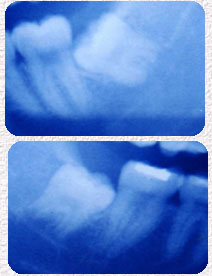
|
| Fig.3-6. An example of how a third molar can
be impacted. |
But its absence nor its presence doesn't have to do with an individuals
intelligence, by the way. The name wisdom tooth is derived from the fact
that perhaps that it erupts at a late, mature age of 17 years and even
later. I will feature a discussion about it on the segment The "Molar
Truth" is... soon. Watch for it! |